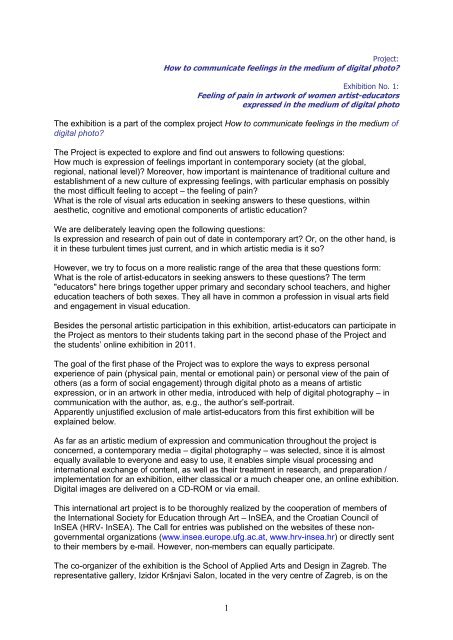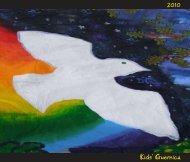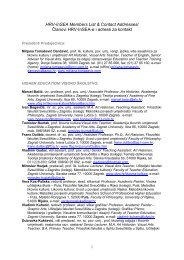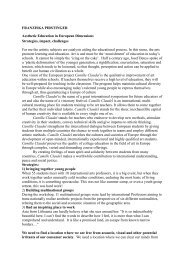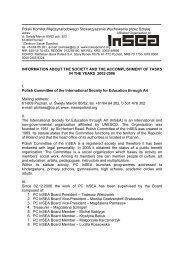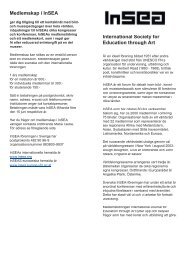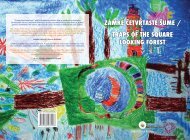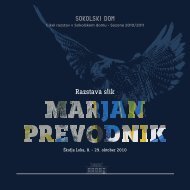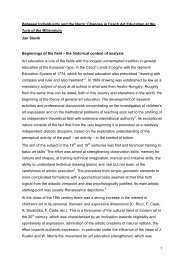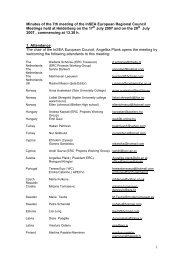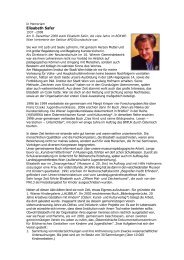Feeling of pain - Catalogue Preface - InSEA Europe
Feeling of pain - Catalogue Preface - InSEA Europe
Feeling of pain - Catalogue Preface - InSEA Europe
Create successful ePaper yourself
Turn your PDF publications into a flip-book with our unique Google optimized e-Paper software.
Project:<br />
How to communicate feelings in the medium <strong>of</strong> digital photo?<br />
Exhibition No. 1:<br />
<strong>Feeling</strong> <strong>of</strong> <strong>pain</strong> in artwork <strong>of</strong> women artist-educators<br />
expressed in the medium <strong>of</strong> digital photo<br />
The exhibition is a part <strong>of</strong> the complex project How to communicate feelings in the medium <strong>of</strong><br />
digital photo?<br />
The Project is expected to explore and find out answers to following questions:<br />
How much is expression <strong>of</strong> feelings important in contemporary society (at the global,<br />
regional, national level)? Moreover, how important is maintenance <strong>of</strong> traditional culture and<br />
establishment <strong>of</strong> a new culture <strong>of</strong> expressing feelings, with particular emphasis on possibly<br />
the most difficult feeling to accept – the feeling <strong>of</strong> <strong>pain</strong>?<br />
What is the role <strong>of</strong> visual arts education in seeking answers to these questions, within<br />
aesthetic, cognitive and emotional components <strong>of</strong> artistic education?<br />
We are deliberately leaving open the following questions:<br />
Is expression and research <strong>of</strong> <strong>pain</strong> out <strong>of</strong> date in contemporary art? Or, on the other hand, is<br />
it in these turbulent times just current, and in which artistic media is it so?<br />
However, we try to focus on a more realistic range <strong>of</strong> the area that these questions form:<br />
What is the role <strong>of</strong> artist-educators in seeking answers to these questions? The term<br />
"educators" here brings together upper primary and secondary school teachers, and higher<br />
education teachers <strong>of</strong> both sexes. They all have in common a pr<strong>of</strong>ession in visual arts field<br />
and engagement in visual education.<br />
Besides the personal artistic participation in this exhibition, artist-educators can participate in<br />
the Project as mentors to their students taking part in the second phase <strong>of</strong> the Project and<br />
the students’ online exhibition in 2011.<br />
The goal <strong>of</strong> the first phase <strong>of</strong> the Project was to explore the ways to express personal<br />
experience <strong>of</strong> <strong>pain</strong> (physical <strong>pain</strong>, mental or emotional <strong>pain</strong>) or personal view <strong>of</strong> the <strong>pain</strong> <strong>of</strong><br />
others (as a form <strong>of</strong> social engagement) through digital photo as a means <strong>of</strong> artistic<br />
expression, or in an artwork in other media, introduced with help <strong>of</strong> digital photography – in<br />
communication with the author, as, e.g., the author’s self-portrait.<br />
Apparently unjustified exclusion <strong>of</strong> male artist-educators from this first exhibition will be<br />
explained below.<br />
As far as an artistic medium <strong>of</strong> expression and communication throughout the project is<br />
concerned, a contemporary media – digital photography – was selected, since it is almost<br />
equally available to everyone and easy to use, it enables simple visual processing and<br />
international exchange <strong>of</strong> content, as well as their treatment in research, and preparation /<br />
implementation for an exhibition, either classical or a much cheaper one, an online exhibition.<br />
Digital images are delivered on a CD-ROM or via email.<br />
This international art project is to be thoroughly realized by the cooperation <strong>of</strong> members <strong>of</strong><br />
the International Society for Education through Art – <strong>InSEA</strong>, and the Croatian Council <strong>of</strong><br />
<strong>InSEA</strong> (HRV- <strong>InSEA</strong>). The Call for entries was published on the websites <strong>of</strong> these nongovernmental<br />
organizations (www.insea.europe.ufg.ac.at, www.hrv-insea.hr) or directly sent<br />
to their members by e-mail. However, non-members can equally participate.<br />
The co-organizer <strong>of</strong> the exhibition is the School <strong>of</strong> Applied Arts and Design in Zagreb. The<br />
representative gallery, Izidor Kršnjavi Salon, located in the very centre <strong>of</strong> Zagreb, is on the<br />
1
list <strong>of</strong> recognized exhibition halls <strong>of</strong> the Croatian Community <strong>of</strong> Independent Artists. The<br />
entries were selected by the jury <strong>of</strong> experts composed <strong>of</strong>: Branka Hlevnjak, art historian,<br />
Danijela Lušin, academic <strong>pain</strong>ter – graphic arts, and photographer, Dijana Nazor, visual arts<br />
teacher, artist and member <strong>of</strong> <strong>InSEA</strong> /HRV-<strong>InSEA</strong>, Barbara Vujanović, art historian, and<br />
Mirjana Tomašević Dančević, art historian and visual arts teacher, visual arts advisor,<br />
president <strong>of</strong> HRV-<strong>InSEA</strong>, member <strong>of</strong> the Board <strong>of</strong> ERC <strong>InSEA</strong>.<br />
The project is in its first phase focused on women primarily because it was supposed that,<br />
due to a specific theme, male artists should submit their photos in considerably smaller<br />
amount than women artists. So, in case <strong>of</strong> their participation, the project would not only be<br />
directed toward the untargeted problem <strong>of</strong> differences in male and female approach to the<br />
theme, but, because <strong>of</strong> the highly disparate samples, the analysis – juxtaposition and<br />
comparison – would also be provided in two groups vastly disproportional to their size.<br />
Finally, such an exhibition concept is expected to prompt at least a few women artisteducators<br />
who, because <strong>of</strong> their numerous duties and responsibilities, have neglected their<br />
art careers, to return to their art production and submit their photos.<br />
On the other hand, all artist-educators interested in this project can equally take part in it<br />
being mentors to their students, and pave the way for future solutions for the launch <strong>of</strong><br />
similar projects.<br />
What has this first exhibition <strong>of</strong> the project shown?<br />
In spite <strong>of</strong> great support given to the Project and interest shown by women artist-educators<br />
from all around the world, a relatively small number <strong>of</strong> them joined the exhibition. The most<br />
common reason given as an excuse in their electronic messages was explained as<br />
significant obligations associated with the start <strong>of</strong> school/academic year. Less frequently<br />
mentioned reasons were the following ones: their quite reduced or completely neglected<br />
artistic activities, lack <strong>of</strong> use <strong>of</strong> digital photography in their artistic expression, as well as –<br />
the fear <strong>of</strong> intensive dealing with the subject <strong>of</strong> <strong>pain</strong>.<br />
Based on the responses and submitted photos, the conclusions are as follows:<br />
Although <strong>pain</strong> is selected as the first issue <strong>of</strong> artistic research project because <strong>of</strong> its<br />
widespread existence in various forms <strong>of</strong> manifestation in people's lives, in contemporary<br />
pr<strong>of</strong>essional and popular discussions, and in certain periods and aspects <strong>of</strong> art history, the<br />
public is still reluctant to talk personally about <strong>pain</strong>, especially not about one’s own <strong>pain</strong>.<br />
(It seems that a similar model behaviour, intensified by the media favouring superficial "cool"<br />
behaviour, are taken by students and young people, who in this way suppress real problems<br />
and the talk about them. On the other hand, it is the arts included in education that <strong>of</strong>fer the<br />
possibility <strong>of</strong> active communication with suppressed feelings and problems, and the world<br />
around them. Furthermore, only the awareness <strong>of</strong> <strong>pain</strong>ful feelings, as contrast, will provide a<br />
full sense <strong>of</strong> joyful feelings. At the same time, this exhibition prepares the artist-educators to<br />
work on a project with students, with an additional need to keep in mind, to collaborate with<br />
school psychologists and educators.)<br />
The feelings <strong>of</strong> <strong>pain</strong> presented in the exhibition catalogue range from those caused by fire<br />
devastating a forest, or very subtle nuances <strong>of</strong> <strong>pain</strong>, to the persistent deep <strong>pain</strong> <strong>of</strong> losing a<br />
child. Regarding the type <strong>of</strong> <strong>pain</strong>, it ranges from mother's loving care for her hypersensitive<br />
child's future, through the horror <strong>of</strong> war and violence, to the physical <strong>pain</strong> <strong>of</strong> childbirth –<br />
blessed with the gift <strong>of</strong> child birth. Most interesting are the supporting brief statements <strong>of</strong> the<br />
authors.<br />
The disparity in quality <strong>of</strong> selected photos only points to the previously mentioned range <strong>of</strong><br />
women educators participating in the exhibition, with an emphasis on the fact that only a<br />
small number <strong>of</strong> them is intensively engaged in photography, and the majority express in the<br />
2
medium <strong>of</strong> photography only occasionally and incidentally. Moreover, applying for the<br />
competition a few educators have just renewed their neglected artistic activity.<br />
In the end, the question remains open regarding all artists-educators:<br />
How much is, in their dedicated commitment to art-pedagogic work, compared with freelance<br />
artists, stimulating or aggravating for them to maintain a parallel role <strong>of</strong> the artist?<br />
Mirjana Tomašević Dančević<br />
3


